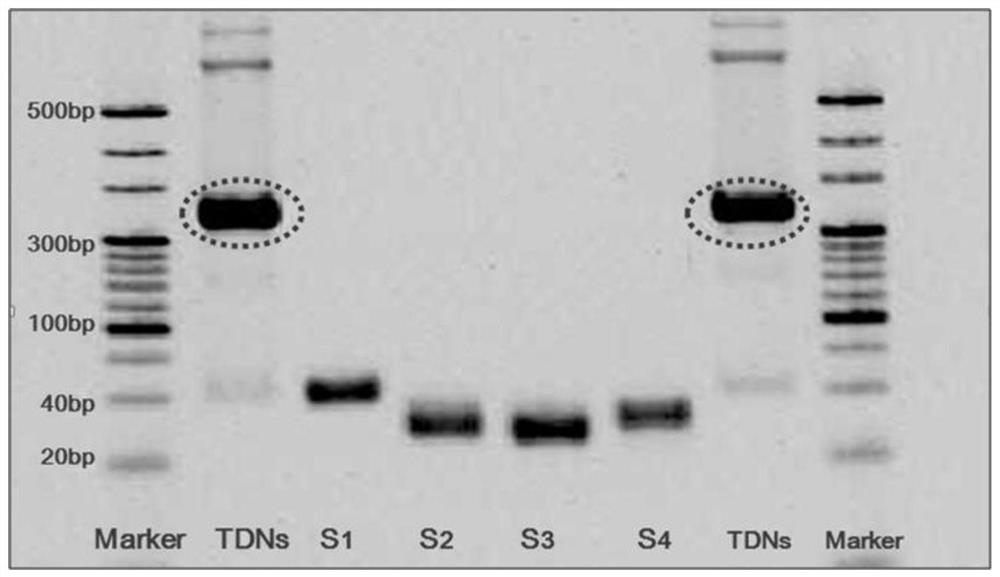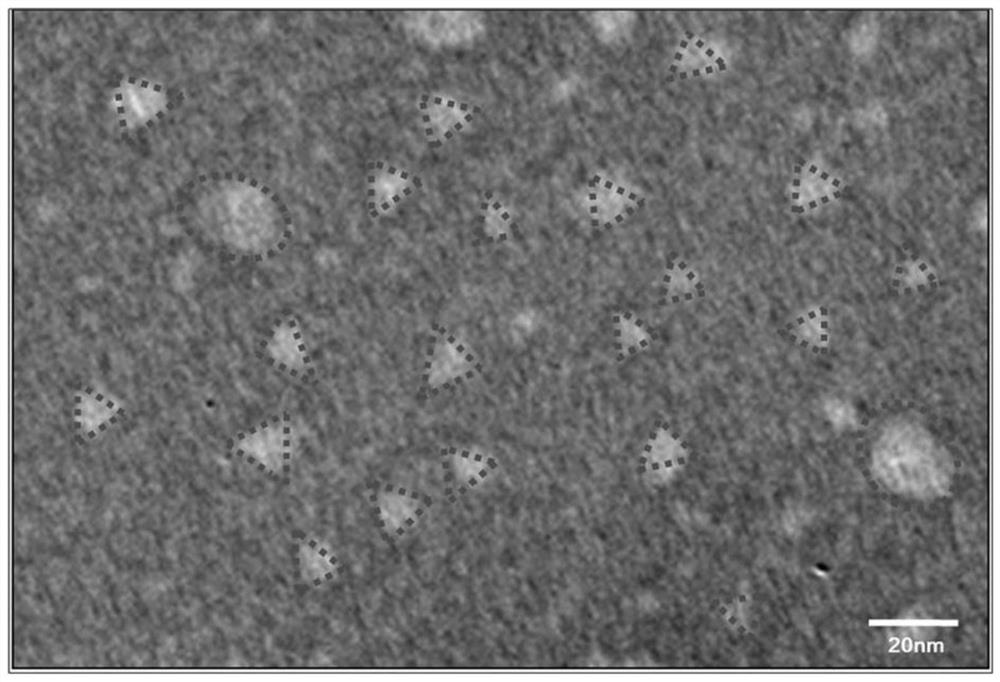Application of dna tetrahedron in preparation of medicine for treating Alzheimer's disease
A technology for Alzheimer's disease and drug preparation, which is applied in the field of nerve repair and can solve the problem of less research on the effects of cell physiological activities.
- Summary
- Abstract
- Description
- Claims
- Application Information
AI Technical Summary
Problems solved by technology
Method used
Image
Examples
Embodiment
[0054] Synthesis of Example TDNs
[0055] 1. Synthesis
[0056] Four kinds of DNA single strands (S1, S2, S3, S4) are dissolved in the TM buffer solution with the same final concentration, wherein, the solute of the TMbuffer solution is Tris-HCl and MgCl , and their concentrations are respectively 10mM and 50mM, and adjusted The pH of the solution was 8.0. Then the mixture was vortexed, mixed, and centrifuged, then placed in a PCR instrument, and the temperature was rapidly raised to 95°C and stabilized for 10-15 minutes, then cooled to 4°C and stabilized for 20 minutes. That is synthesized as figure 1 The tetrahedral structure shown.
[0057] The sequence of the DNA single strand is shown in Table 1.
[0058] Table 1 Sequence of TDNs single strand
[0059]
[0060] 2. Identification
[0061] 2.1 Gel electrophoresis
[0062] A polyacrylamide gel was prepared by using 4.2mL distilled water, 1.2mL 40% acrylamide, 0.6mL 10×TAE, 60μL 10% Aps and 6μL TEMED;
[0063] Then...
experiment example 1A
[0072] Experimental example 1 Aβ external treatment of PC12 cells can simulate Alzheimer's disease
[0073] 1. Method
[0074] (1) Inoculate PC12 cell suspension (100 μL / well) in a 96-well plate, and place the culture plate in an incubator for pre-culture for 24 hours (37°C, 5% CO 2 ), then reduce the serum concentration in the culture medium consisting of DMEM+10% serum+1% double antibody from 10% to 6%, and cultivate it in an incubator for 6 hours (37°C, 5% CO 2 ), then reduce the serum concentration in the culture medium from 6% to 0, and cultivate in the incubator for 1 hour (37°C, 5% CO 2 ).
[0075] (2) Divide the cultured cell suspension into a control group and an experimental group, and add different concentrations of Aβ to the experimental group 25-35 , the control group was added with the same amount of serum, and then cultured in the incubator for 24h (37 ° C, 5% CO 2 ), after the end of the culture, add 10 μL of CCK-8 solution to each well, and avoid the produ...
experiment example 2
[0079] Experimental example 2 TDNs reduce the active damage of Aβ to PC12 cells
[0080] 1. Method
[0081] (1) Inoculate PC12 cell suspension (100 μL / well) in a 96-well plate, and place the culture plate in an incubator for pre-culture for 24 hours (37°C, 5% CO 2 ), then reduce the serum concentration in the culture medium consisting of DMEM+10% serum+1% double antibody from 10% to 6%, and cultivate it in an incubator for 6 hours (37°C, 5% CO 2 ), then reduce the serum concentration in the culture medium from 6% to 0, and cultivate in the incubator for 1 hour (37°C, 5% CO 2 ).
[0082] (2) Divide the cultured cell suspension into blank control group, TDNs group, AD cell model group and AD cell model group pretreated by TDNs; wherein, the blank control group does not add Aβ 25-35 ; The AD cell model group pretreated with TDNs was first pretreated with 250nM TDNs for 6h, and then added Aβ at a concentration of 25μM 25-35 ; AD cell model group was pretreated with serum-free ...
PUM
 Login to View More
Login to View More Abstract
Description
Claims
Application Information
 Login to View More
Login to View More - R&D
- Intellectual Property
- Life Sciences
- Materials
- Tech Scout
- Unparalleled Data Quality
- Higher Quality Content
- 60% Fewer Hallucinations
Browse by: Latest US Patents, China's latest patents, Technical Efficacy Thesaurus, Application Domain, Technology Topic, Popular Technical Reports.
© 2025 PatSnap. All rights reserved.Legal|Privacy policy|Modern Slavery Act Transparency Statement|Sitemap|About US| Contact US: help@patsnap.com



